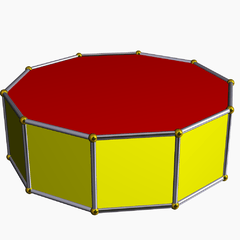
Stunt
A stunt is an unusual and difficult physical feat or an act requiring a special skill, performed for artistic purposes usually on television, theatre, or cinema. Stunts are a feature of many action films. Before computer generated imagery special effects, these effects were limited to the use of models, false perspective and other in-camera effects, unless the creator could find someone willing to jump from car to car or hang from the edge of a skyscraper: the stunt performer or stunt double.
Types of stunt effects
Practical effects
One of the most-frequently used practical stunts is stage combat. Although contact is normally avoided, many elements of stage combat, such as sword fighting, martial arts, and acrobatics required contact between performers in order to facilitate the creation of a particular effect, such as noise or physical interaction. Stunt performances are highly choreographed and may be rigorously rehearsed for hours, days and sometimes weeks before a performance. Seasoned professionals will commonly treat a performance as if they have never done it before, since the risks in stunt work are high, every move and position must be correct to reduce risk of injury from accidents. Examples of practical effects include tripping and falling down, high jumps, extreme sporting moves, acrobatics and high diving, spins, gainer falls, "suicide backflips," and other martial arts stunts.
Stunt (gridiron football)
A stunt in American football and Canadian football, sometimes called a twist, is a planned maneuver by a pair of players of the defensive team by which they exchange roles to better slip past blockers of the offensive team at the beginning of a play.
The purpose of a stunt is to confuse opposing blockers, which is an aid to the defense in rushing an opposing forward pass or kick. The main weakness of a stunt is that it is more vulnerable than average to running plays by the opposing team. In most cases, the defense will not use a play incorporating stunting if it expects a running play from the offense.
There are two main types of stunts. In one, a line player, who would otherwise try to charge forward, instead drops back, and a nearby linebacker or defensive back charges forward instead. In the other, which is known as cross-rushing, line players, instead of charging straight ahead, cross paths. One of them may follow a looping path that goes behind the other before moving forward (in which case the stunt is called a "loop"), or one may wait for the other to penetrate slightly first, and then cross behind, their paths angling across each other. In some variants, a rushing player will run around more than one rushing teammate.
Stunt (disambiguation)
A stunt is a difficult or unusual feat performed for film or theatre.
Stunt or Stunting may also refer to:
See also
Dip (Catalan myth)
In Catalan myth, Dip (Catalan pronunciation: [ˈdip]) is an evil, black, hairy dog, an emissary of the Devil, who sucks people's blood. Like other figures associated with demons in Catalan myth, he is lame in one leg. Dip is pictured on the escutcheon of Pratdip.
See also
Sources
El gran libro de los vampiros by Angel Gordon, Morales y Torres editores.Spanish
External links

Decagonal prism
In geometry, the decagonal prism is the eighth in the infinite set of prisms, formed by ten square side faces and two regular decagon caps. With twelve faces, it is one of many nonregular dodecahedra. The decagonal prism has 12 faces, 30 edges, and 20 vertices. If faces are all regular, it is a semiregular or prismatic uniform polyhedron.
Uses
The decagonal prism exists as cells in two four-dimensional uniform 4-polytopes:
Related polyhedra
External links

Dip (exercise)
The dip is an exercise used in strength training. Narrow, shoulder-width dips primarily train the triceps, with major synergists being the anterior deltoid, the pectoralis muscles (sternal, clavicular, and minor), and the rhomboid muscles of the back (in that order). Wide arm training places additional emphasis on the pectoral muscles, similar in respect to the way a wide grip bench press would focus more on the pectorals and less on the triceps.
Classic meaning
In past decades, the term floor dip was used in place of what is now called a press-up or push-up.
Modern meaning
To perform a dip, the exerciser hangs from a dip bar or from a set of rings with their arms straight down and shoulders over their hands, then lowers their body until their arms are bent to a 90 degree angle at the elbows, and then lifts their body up, returning to the starting position. Short people are able to cope better with a narrower grip, but not with a wider one.
Due to natural flexibility in the shoulder joints, it is important to try to "lock" them as much as possible during this exercise. Otherwise, the supporting rotator cuffs may become strained.
Podcasts:

-
by Bingo Players
When I Dip
by: Bingo PlayersWhool!
Yeah!
When i dip, you dip, we dip
Whool!
*instrumental*
When i dip, you dip, we dip
*instrumental*
Whool!
